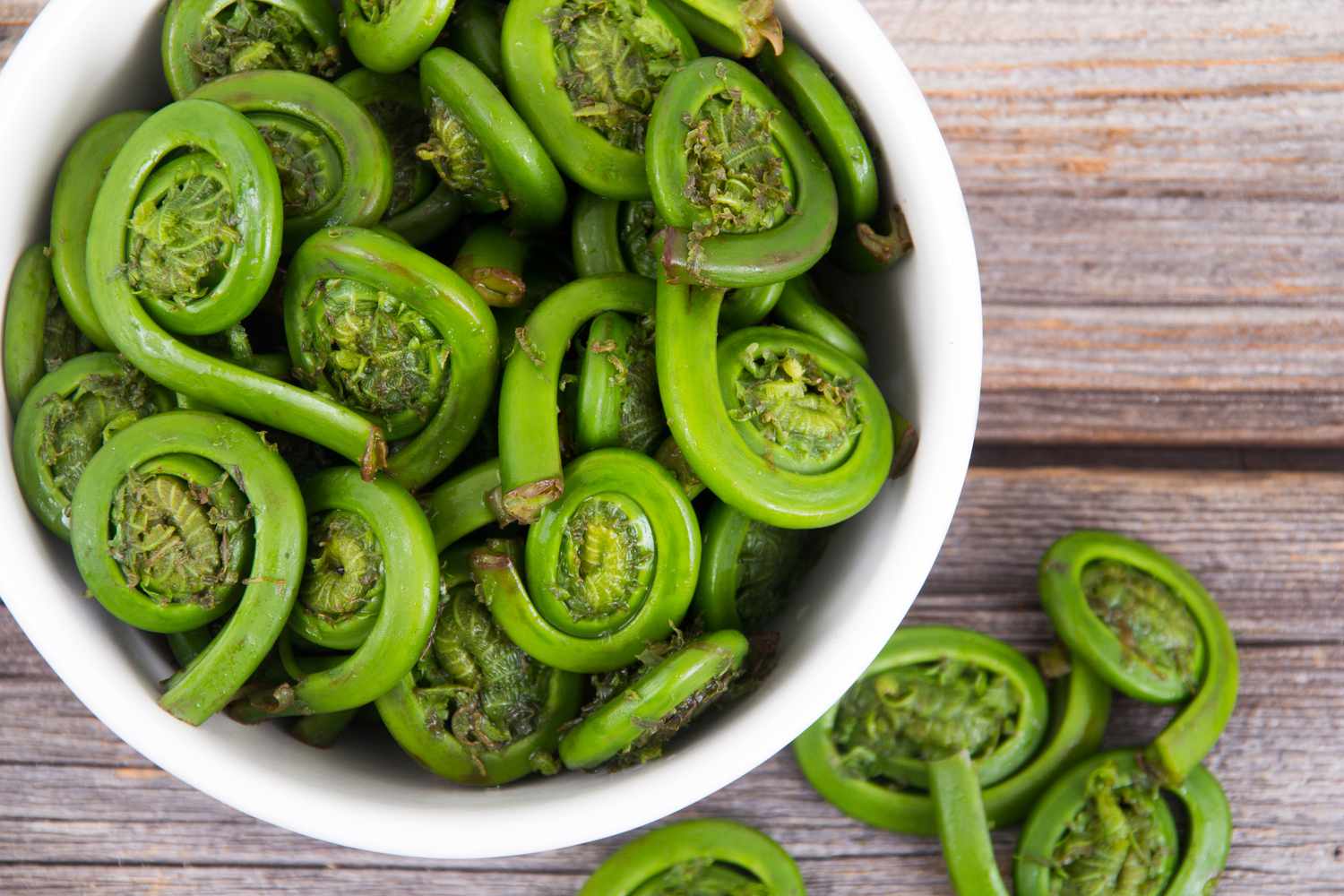
The best ways to eat fiddlehead ferns, according to an expert
As the first signs of spring emerge, you might see one of nature’s most interesting and seasonal edible delicacies, fiddleheads, in the woods or at your farmers market or specialty grocery store. These tightly coiled greens resemble the scroll of a violin and are valued for their crisp texture and earthy flavor. Whether lightly sautéed with butter and garlic or tossed into a fresh spring salad, fiddleheads bring elegance and whimsy to any dish. They’re also packed with vitamins A and C, making them as nourishing as they are delicious. We spoke to a wild foods expert and chef to find out the best way to prepare them so you can take advantage of their brief but beautiful season.
What Are Fiddleheads?
By Eve Livesey / Getty Images
Fiddleheads are the young, coiled fronds of certain fern species, most commonly the ostrich fern. “Theys are a bit like a cross between green beans and asparagus,” says Alan Bergo, author of The Forager Chef’s Book of Flora, who has researched and written extensively about fiddleheads. “That said, there’s nothing truly like a fiddlehead, and the rich, earthy flavor doesn’t really have a substitute.”
Fiddlehead ferns grow in cool, damp environments, primarily in the northern regions of North America, Europe, and Asia. In the United States, they’re usually found in shady, woodland areas and along riverbanks—commonly in the Northeast, the Midwest around the Great Lakes, and in the Pacific Northwest. Conveniently enough, they usually grow in clusters alongside other wild spring delicacies like ramps and morel mushrooms!
Shopping for Fiddleheads
When buying fiddleheads, look for ones that are fresh. They should feel firm and crisp, not wilted or slimy. Avoid any that are brown, bruised, or have a strong odor.
Fiddlehead season: Many specialty grocery stores and farmers markets carry fiddleheads in early spring. Depending on where you live, this is usually from late April to early June.
Storing Fiddleheads
Fiddleheads are durable and have a long shelf life. Store them loosely wrapped in a paper towel inside an open plastic bag in the fridge to maintain freshness. Bergo says he has picked and stored fiddleheads in his refrigerator for over a month without much of loss in quality. Store-bought ones may not be as fresh but should last at least a couple of weeks.
The Best Way to Cook Fiddlehead Ferns
Before cooking, you can rinse them thoroughly and remove any brown papery husks, but Bergo suggests an even easier method:
Blanch First
The only thing you need to do is blanch them and let them cool, says Bergo. Blanching has two benefits: It helps to remove the outer brown papery covering, which is bitter and not good to eat. (He says you’ll notice the cooking liquid turns very dark after blanching.) And, blanching preserves the bright green color of the fiddleheads.
Bergo says he would never serve fiddleheads without first blanching them. He thinks it should be the standard for preparing fiddlehead ferns. “While they’re cooked from raw in different Asian cuisines, this makes them discolor and not look attractive, so I don’t recommend it. While some people will say you can just throw them in a pan, the heat of a saute pan is more uneven than boiling, and will also tend to make them discolor. When sauteed they can also discolor before they become tender, which means you’ll have crunchy, half-black mottled fiddleheads.”
How to Eat Fiddleheads
Use like peas or asparagus: Once they are blanched, Bergo uses fiddleheads anywhere he’d use fresh green vegetables like peas or asparagus. “As they’re a spring vegetable, they take well to light preparations where they won’t get overcooked which can make them mushy and soft.”
Stir fry: He suggests stir-frying them with a little ginger, garlic, hot chili, soy and serving with rice. “Especially wild rice as I’m from Minnesota!”
Add to soup: When adding them to a soup, Bergo suggests blanching them quickly so they don’t discolor the broth, then throwing the ferns in only a minute or two before serving.
Salad: Fiddleheads can also be eaten cold after blanching—their tight coils are well-designed for soaking up dressing, and a fiddlehead salad is something Bergo makes every year.
What to Avoid With Fiddleheads
lisegagne / Getty Images
There are two opposite things to be aware of:
Fiddleheads should always be cooked: Avoid serving them raw. “While it’s probably not bad to nibble one or two, the raw flavor is inferior to when they’re lightly par-cooked and reheated or seasoned and eaten in a salad. Eating fiddleheads raw is also well documented to cause indigestion,” says Bergo.
But do not overcook them: Avoid overcooking fiddleheads or preparing them in any way where they’re baked for a long time, says Bergo. The fiddleheads loose their bright color and crunchy texture. A dish like a fiddlehead lasagna, for example, would probably be a mistake. “They’ll become army green and the texture turns mushy.”
Beyond the Plate
Along with being delicious, fiddlehead ferns are also visually beautiful and are highly decorative. “They’re a wonderful edimental, or edible ornamental,” says Bergo. “I think everyone who lives within their range and has the ability should plant them in their yard. While it will take a few years to get enough to harvest, when you see them come up you’ll know it’s time to start looking for wild ones that you can pick, on private land, of course.”










